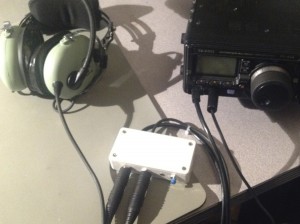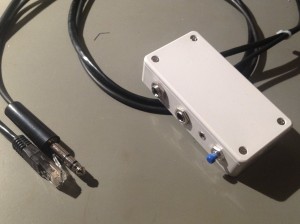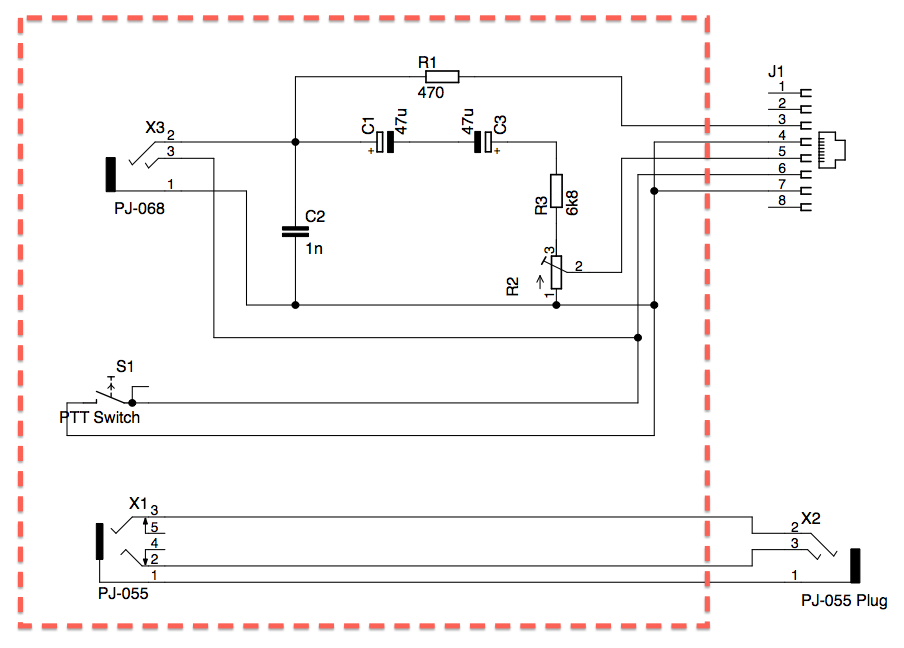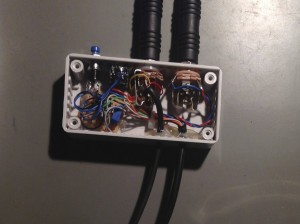 Those among us who do both flying and ham radio have a dilemma: as a pilot we usually own a high grade aviation noise canceling headset that is generally of better quality than most headsets available in the ham radio market (I personally own a David Clark H10-13.4 headset … try to find a passive headset with similar robustness). However, all standards regarding plugs etc. are different and it looks like there is no commercial solution available to interface your aviation type headset with your ham radio gear – at least to the best of my knowledge.
Those among us who do both flying and ham radio have a dilemma: as a pilot we usually own a high grade aviation noise canceling headset that is generally of better quality than most headsets available in the ham radio market (I personally own a David Clark H10-13.4 headset … try to find a passive headset with similar robustness). However, all standards regarding plugs etc. are different and it looks like there is no commercial solution available to interface your aviation type headset with your ham radio gear – at least to the best of my knowledge.
So, in the best tradition of ham spirit, I decided to build an interface. Since I still use my headset for flying cutting off the plugs and replacing them with ham plugs wasn’t an option. First problem: where do you find the correct female connector? The phone part of a civil fixed wing aviation headset (caution: different standards for military, helicopter, and commercial airliner!) uses the standard 6,3mm headphone plug equivalent to your stereo headphone. The microphone, however, uses a 5,6 mm three pole plug. No chance to get them at your local electronics dealer. Fortunately there are a couple of aviation specialty mail oder stores than can help you out … for instance Friebe, Siebert, Büscher in Germany, or Aircraft Spruce in the US).
Plugs for the FT-897 are simple. Headphone plug is a standard 6,3mm phone jack (you can actually plug the Aviation Headset right in if you want to), the mic jack is a standard RJ-45 jack. Since I didn’t want to buy the necessary crimping equipment I just used a surplus network cable.
The interface is built in a small box containing the receiving sockets for the aviation headset, the cables to be connected to the transceiver (phone and mic, both ca. 1,5m long), a push-to-talk switch (PTT), and a jack to connect an additional external PTT switch. This way the interface box is very conveniently located in the middle between the headset and the transceiver which gives you additional room to move and enables you to overate the PTT switch holding the interface box in your hand. The following picture shows the overall configuration.
The circuit itself is simple and requires only a few standard parts to provide the microphone with the necessary power and to adjust the microphone output level.
Pin 3 provides via the 470 Ohm resistor the necessary power for the mic, the two 47uF capacitors remove the dc component for the audio input to pin 5. The 1k poti / 6k8 Ohm combination allows for the necessary output level adjustment. A 1nF capacitor removes any HF components that might end up in the system. I decided to include the pin 3 (tip connector) of the headset mic plug that is used in aviation systems as PTT switch. That enables me to use other aviation mics (e.g., handheld mics) with the same interface. Since the aviation standard does not provide a different ground for PTT and MIC I had to connect pins 4 and 7 at the Yaesu Mic connector.
As you see, all components fit comfortably in a 100x50x25 mm box.
Before closing the box adjust the microphone output level using the built in ALC meter in the FT-897. Fine tuning can be accomplished with the “SSB Mic Gain” menu in the FT-897 settings (menu no. 81).
My experiences with the configuration are extremely positive so far. My David Clark headset provides excellent noise cancellation abilities and the noise suppressing microphone works very nicely with my Yaesu rig.
Any further comments and tips are highly welcome.
Vy 73 de Jens, DJ2UM




Dear Mr Jens,
Can I have you email address? I need your help, if you can, for military headset w/microphonedynamic M-87/AIC. I would like to send you the pictures of my headset to understand if your circuit can help me to give power at that mic. I use a TS -2000 or TS-440.
Thanks and ’73
Alessandro
Dear Alessandro,
I just sent you an eMail so you can provide me with a picture of your headset. Let’s see what what we can do.
Best regards – Jens
I have a question with this circuit adapter.
Have a Flightcom 40LX Headset + FT-897D . In FM the modulation is correct but in HF it´s impossible a lot of gain and noises.
The schema is correct?
Any suggestion?
Thanks!
Hi, I would assume that you have to modify, i.e. lower, the NF level going to the transceiver. If the range of the trimmer doesn’t work you might want to change the resistor in line with the trimmer.
Let me know if this works.
Best regards – Jens
Hello
I have a TS2000 like Alessandro with an aircraft headset. Did you found a solution ?
Thank you in advance
Best regards – 73
Hi Thierry, unfortunately not. Can you describe your problems in greater detail?
Best regards and vy 72 de Jens
Dear Mr Jens,
I have the same transceiver than Alexandro. I try to create your solution but it doesn’t works correctly.
Did you found a solution for Alexandro?
Best 73
Thierry
Sehr geehrter OM Moeller,
Da ich einen ähnlichen Umbau für meinen IC 7200 und ein TELEX airman 750 beabsichtige, würde ich mich freuen, wenn ich Ihnen einige entsprechenden Fragen stellen dürfte. Das Airman 750 besitzt bereits einen eingebauten SMD-Verstärker, dessen Schaltung mir vorliegt. Dennoch sind mir dort zwei Dinge nicht ganz klar.
Hallo,
da bin ich wahrscheinlich auch überfragt. Meine Vermutung wäre allerdings, dass die Schaltung mit anderen Headsets ähnlich funktionieren müsste. Schließlich lassen sich die Headsets alle in Luftfahrzeugen der General Aviation problemlos betreiben.
vy 72 de Jens, DJ2UM
Hello,
Do you know if there is any difference with the plug port for the Yaesu and a Kenwood TM-281a? The specific setup that I would like to use is the Kenwood and the ASA HS-1A headset. Your assistance would be much appreciated.
Hi Josh,
Sorry, unfortunately I have absolutely no information on the Kenwood product line.
If you find something, feel free to post your insights here for the benefit of the community.
vy 73 de Jens, DJ2UM
Hi, Jens,
Thanks for posting this circuit. I do have one question. Not sure what a 6k8 resistor is. Is that a 6.8 k ohm?
Thanks, es 73, Gary KW4MG
PS. Just had my H10-40 rebuilt at David Clark and they did an incredible job. It’s at least 30 years old, and it now looks and works brand new!
Hi Gary,
Yes, you are correct. 6k8 means 6.8 kiloOhms.
Great news on your refurbished DC headset, I didn’t know they offer this service.
I upgraded to a Bose A20 last December. I thought it might make sense to protect my hearing a little bit better since I got my flight instructor rating last year and started to log about 100h+ annually. I have to say, the difference is remarkable.
Best regards, vy 73 de Jens, DJ2UM
Good afternoon from the USA,
Thanks for this great information. Quick question. If I have a radio that provides a bias voltage of 8 volts rather than the 5 volts from the FT-897, how would you modify the circuit? Would you just change R1 from a 470 ohm resistor up and change C1 and C3 as well or would you merely change R1 to reduce further?
Thanks!
Peter:
It should actually work just fine. Here is a snippet I found on Wikipedia regarding the phantom power for aviation microphones: “[…]Phantom power is sometimes used by workers in avionics to describe the DC bias voltage used to power aviation microphones, which use a lower voltage than professional audio microphones. Phantom power used in this context is 8 to 16 volts DC in series with a 470 ohm (nominal) resistor as specified in RTCA Inc. standard DO-214.[18] These microphones evolved from the carbon microphones used in the early days of aviation and the telephone which relied on a DC bias voltage across the carbon microphone element. […]”
So, according to this you should be just fine with leaving the resistor as is. Makes me wonder why it works with the 5V on my Yaesu rig, though …
Best regards from Germany
Jens
Would you be interested in building me one. For
A price? I have model number H10-37 Headset and a yaesu ft897d. Or draw plans so I may have one made. I think they would be a big seller on E-bay. Thanks for your time. Bill
Hello. I want one. How much for you to build me One? Thanks Bill
Hey Bill, I haven’t thought about this yet. But given the unexpected resonance on this blog entry I’ll look into it.
Jens,
What would be required to power this with a 9 volt battery? While I have a Yaesu radio, I’d like to make this unit compatible with any radio (Kenwood radios do not provide a DC Bias voltage best of my knowledge) . Would the positive end of the battery go into the 470 Ohm resistor? Would about the negative end of the battery? Would this be connected to the ground of the radio? I plan to make different interface cables with ethernet on one end and the appropriate pin connector on the other.
Thank you so much for you help.
I use (the principle of) this circuit for the UFM A100T.
This is the microphone extension for the Bose QC15, making it an ANR headset.
Some changes :
C’s changed to one 22uF capacitor.
Output : only a fixed 1K resistor.
In the UFM the output can be set (minimum is ok)
All components fit inside a 8 pole microphone connector, which replaces the 5 mm jack plug.
It works fine.
What if your rig doesn’t use a modular Mic jack. How would this change the circuit ?
Hmmm … not sure. Depends on where the phantom power is supplied and how the PTT works. Do you have specs available?
Hi there Jens.
This is exactly what I have been looking for. Thank you so much. I am looking forward to constructing this and seeing how it goes.
Thanks! Let me know how it works!
was wondering if this could work for older yaesu Radios like the Ft-757GXII
Don’t know and unfortunately I don’t have the means (access to radio) to test it … let me know if you find out more. But in general, you have to look for two things: (1) Does the radio provide the necessary phantom power for the mic (2) how is the PTT function controlled (the newer Yaesu radios ground the mic line through a 10k resistor). Other than that the circuit should be pretty robust.
Hi jens
i would like to know if my sennheiser headset hme-100 can connect with ft897 using your diagram.would appreciate if u can email me with detail diagram so i can build up my own.i cant find any 5.35mm in any elect store.
thanks.
9W2NDQ
73
The HME-100 should work fine with the circuit. Finding the 5.35 mm socket can be a little bit of a hassle. You probably have to go to an aviation supply store. Try http://www.aircraftspruce.com for example. Another option would be to visit the next general aviation airport in your vicinity and locate the avionics maintenance shop. They will probably have some on stock.
vy 73 de Jens, DJ2UM
Pingback: Aircraft headset to ham radio adapter – Docs by Design
Any idea for connection to ICOM 756 or ICOM 7300
73
ta5fa
Sorry, I am not familiar with ICOM radios.
We are starting a aviation unit here at our local sheriff’s office. We have installed a Motorolia PM400. My thought since we can not find a headset the will plug into the PM400 wanted to see if you would consider building a adapter box. My thoughts was to have someone add extra set plugs from headset with PTT switch on one ear cuffs to transmit the PM400. So in general they will be 2 sets aviation plugs in. One going to the aircraft’s intercom for aviation side, other set plugs going to the PM400 to transmit to other ground units.
I have David and Clark Model H10-30
Any advise would be appreciated.
Sorry for my late reply … I think when it comes to fixed istallations in aircraft you should probably contact your local avionics shop and ask them for advice. My preferred way would be to connect the radio to the audio panel and have it fully integrated in your avionics stack. If you have something like a Garmin GMA 340 installed you can connect up to transceivers. Let me know how you solve the problem.
What’s the rating on R2 rheostat ? 100 ohms ? 1000 ??
1000 Ohms, it’s mentioned in the text but I forgot to label it correctly in the schematics … sorry!
Thank you co much for this!! I built the box based on your specs, but have a problem. This is the first time I’ve tried to build a project like this or solder a proto board, so I’m very new to this. I have a lightspeed headset. On 2m (FM), the reports are excellent. However on SSB on 20 or 40m it sounds horrible. Any ideas what the problem might be?
Hallo Jens,
ich möchte mir Deine Adapterbox nachbauen.
Jetzt bin ich gerade mit der Bestellung der Bauteile beschäftigt. Da ich bisher in der Auslegung der Bauteile überhaupt keine Erfahrung habe, bin ich mir unsicher über die Details der einzelnen Bauteile. So z.B. bei dem Poti. Wie hoch muss es belastbar sein? Die Widerstände: Welche Toleranzen dürfen sie aufweisen und auch hier die Frage nach der Belastbarkeit….
Könntest Du hier bitte kurz Hilfestellung geben?
73, Rico, DG5BQ
Thanks for the post. I was able to pick up a Softcomm headset at a local thrift store for a great price after quickly pulling up your article to find out if I could adapt an aviation headset to my 897D. Going to Skycraft on Friday to purchase parts for the build. Haven’t tried a DIY project in several years, so I’m looking forward to trying my hand again.
Great, good luck with the project. Drop me a note if you need any assistance. By 73 …
I found a SoftComm Chancellor headset, which has a ptt button built into the right-side earpiece. Is it possible to remove the Mic plug and connect an rj-45 connector directly onto the cable?
I think you have to integrate some circuitry. First you need some voltage divider to get the correct power fort he mic, the you have to modify the PTT switch which works completely different with avionic systems. I would probably integrate everything in the ear cup of the headset. If you design something with SMT or with radial components with free floating connections you should be able to miniaturize the circuit sufficiently to fit into the ear cup. Let me know how it works.
Hello,
Do you make and sell interface boxes that would allow me to use a pair of David Clark headsets with my Icom 7300?
Dear Mr Jens,
Can I have you email address? I need your help
I have a headset with a u174 connector,
do you have a model of the interface with U174 / U NEXUS plug?
Thanks
I have an Aviation Communications AC-800S headset. It has a built in PTT which is convenient for this project. I built the circuit from the QST hints and kinks article on a self-etched pcb. It fits into one of the ear cups along with a micro switch to switch between normal and DX curves. My issue with it is there was no bass with the 10 microfarad caps. I replaced them with 33 microfarad caps and I think that helped a little but if my calculations are correct, I shouldn’t have to go any higher to pass any lower frequencies in my voice. I am still considering trying 47 microfarad. Is the audio still bright on your adapter? I kinda wonder if it is just my microphone even though it should go down to like 100hz.
Hi Jens. I have built your interface for using a David Clark H10-13.4 headset with a Yaesu rig and it works fine. However, I’m not used to using headsets without a sidetone and it feels strange without one. Therefore, would you have details of a modification I could make to your interface that will give me a sidetone, please?
Blue skies,
Roger
That‘s an interesting question, haven‘t thought about it. Ideally you would generate some feed back from the outgoing signal, like you do in an aviation transceiver. That gives you, besides the help to modulate your voice, an ongoing check of your transmitter functionality.
That would require that the transceiver provides that signal to the audio out port. Not sure that you can do that with a Yaesu system. I know that the Elecraft K3 has that option (owned one of these in the past).
Another option would be to include a separate audio amplifier in the interface and generate that signal directly from the mic. A simple cirquit with an LM386 should probably work. You just have to find a way to switch it off during receiving (unless you want to include an intercom function for a second headset … hey, there‘s another cool idea).
Give me some time to think about it, it definitely would be a cool feature.
Radios like the FT-891 have a ‘monitor’ function. If you turn that on and set an appropriate level you have sidetone 🙂
I’m just about to build this interface for my FT-891, thanks for the info!
You’re welcome … let me know how it works out! Cheers – Jens
Jens,
I found a article you put out about building an interface for the above title on a website of dj2um.com and I was wondering if you would be able to build one for me?
I have a David Clark H10-80 that is like brand new that I was using back when I flew a Gyrocoptor for many years but quit flying. I would Like to use with my Yaesu FTM-200dr mobile radio in my Jeep Rubicon.
Thank you for your time.
Mark Blume
mblumewi@gmail.com
Are you still taking questions about aviation headsets to ham radios?